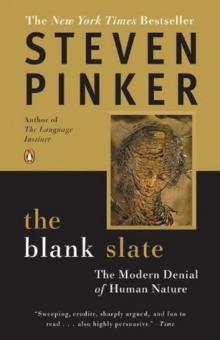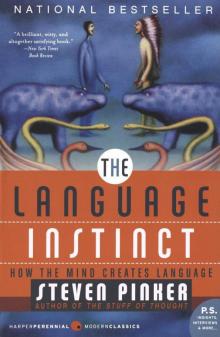- Home
- Steven Pinker
The Language Instinct: How the Mind Creates Language Page 7
The Language Instinct: How the Mind Creates Language Read online
Page 7
Among Whorf’s “kaleidoscopic flux of impressions,” color is surely the most eye-catching. He noted that we see objects in different hues, depending on the wavelengths of the light they reflect, but that physicists tell us that wavelength is a continuous dimension with nothing delineating red, yellow, green, blue, and so on. Languages differ in their inventory of color words: Latin lacks generic “gray” and “brown”; Navajo collapses blue and green into one word; Russian has distinct words for dark blue and sky blue; Shona speakers use one word for the yellower greens and the greener yellows, and a different one for the bluer greens and the nonpurplish blues. You can fill in the rest of the argument. It is language that puts the frets in the spectrum; Julius Caesar would not know shale from Shinola.
But although physicists see no basis for color boundaries, physiologists do. Eyes do not register wavelength the way a thermometer registers temperature. They contain three kinds of cones, each with a different pigment, and the cones are wired to neurons in a way that makes the neurons respond best to red patches against a green background or vice versa, blue against yellow, black against white. No matter how influential language might be, it would seem preposterous to a physiologist that it could reach down into the retina and rewire the ganglion cells.
Indeed, humans the world over (and babies and monkeys, for that matter) color their perceptual worlds using the same palette, and this constrains the vocabularies they develop. Although languages may disagree about the wrappers in the sixty-four crayon box—the burnt umbers, the turquoises, the fuchsias—they agree much more on the wrappers in the eight-crayon box—the fire-engine reds, grass greens, lemon yellows. Speakers of different languages unanimously pick these shades as the best examples of their color words, as long as the language has a color word in that general part of the spectrum. And where languages do differ in their color words, they differ predictably, not according to the idiosyncratic taste of some word-coiner. Languages are organized a bit like the Crayola product line, the fancier ones adding colors to the more basic ones. If a language has only two color words, they are for black and white (usually encompassing dark and light, respectively). If it has three, they are for black, white, and red; if four, black, white, red, and either yellow or green. Five adds in both yellow and green; six, blue; seven, brown; more than seven, purple, pink, orange, or gray. But the clinching experiment was carried out in the New Guinea highlands with the Grand Valley Dani, a people speaking one of the black-and-white languages. The psychologist Eleanor Rosch found that the Dani were quicker at learning a new color category that was based on fire-engine red than a category based on an off-red. The way we see colors determines how we learn words for them, not vice versa.
The fundamentally different Hopi concept of time is one of the more startling claims about how minds can vary. Whorf wrote that the Hopi language contains “no words, grammatical forms, constructions, or expressions that refer directly to what we call ‘time,’ or to past, or future, or to enduring or lasting.” He suggested, too, that the Hopi had “no general notion or intuition of TIME as a smooth flowing continuum in which everything in the universe proceeds at an equal rate, out of a future, through a present, into a past.” According to Whorf, they did not conceptualize events as being like points, or lengths of time like days as countable things. Rather, they seemed to focus on change and process itself, and on psychological distinctions between presently known, mythical, and conjecturally distant. The Hopi also had little interest in “exact sequences, dating, calendars, chronology.”
What, then, are we to make of the following sentence translated from Hopi?
Then indeed, the following day, quite early in the morning at the hour when people pray to the sun, around that time then he woke up the girl again.
Perhaps the Hopi are not as oblivious to time as Whorf made them out to be. In his extensive study of the Hopi, the anthropologist Ekkehart Malotki, who reported this sentence, also showed that Hopi speech contains tense, metaphors for time, units of time (including days, numbers of days, parts of the day, yesterday and tomorrow, days of the week, weeks, months, lunar phases, seasons, and the year), ways to quantify units of time, and words like “ancient,” “quick,” “long time,” and “finished.” Their culture keeps records with sophisticated methods of dating, including a horizon-based sun calendar, exact ceremonial day sequences, knotted calendar strings, notched calendar sticks, and several devices for timekeeping using the principle of the sundial. No one is really sure how Whorf came up with his outlandish claims, but his limited, badly analyzed sample of Hopi speech and his long-time leanings toward mysticism must have contributed.
Speaking of anthropological canards, no discussion of language and thought would be complete without the Great Eskimo Vocabulary Hoax. Contrary to popular belief, the Eskimos do not have more words for snow than do speakers of English. They do not have four hundred words for snow, as it has been claimed in print, or two hundred, or one hundred, or forty-eight, or even nine. One dictionary puts the figure at two. Counting generously, experts can come up with about a dozen, but by such standards English would not be far behind, with snow, sleet, slush, blizzard, avalanche, hail, hardpack, powder, flurry, dusting, and a coinage of Boston’s WBZ-TV meteorologist Bruce Schwoegler, snizzling.
Where did the myth come from? Not from anyone who has actually studied the Yupik and Inuit-Inupiaq families of polysynthetic languages spoken from Siberia to Greenland. The anthropologist Laura Martin has documented how the story grew like an urban legend, exaggerated with each retelling. In 1911 Boas casually mentioned that Eskimos used four unrelated word roots for snow. Whorf embellished the count to seven and implied that there were more. His article was widely reprinted, then cited in textbooks and popular books on language, which led to successively inflated estimates in other textbooks, articles, and newspaper columns of Amazing Facts.
The linguist Geoffrey Pullum, who popularized Martin’s article in his essay “The Great Eskimo Vocabulary Hoax,” speculates about why the story got so out of control: “The alleged lexical extravagance of the Eskimos comports so well with the many other facets of their polysynthetic perversity: rubbing noses; lending their wives to strangers; eating raw seal blubber; throwing Grandma out to be eaten by polar bears.” It is an ironic twist. Linguistic relativity came out of the Boas school, as part of a campaign to show that nonliterate cultures were as complex and sophisticated as European ones. But the supposedly mind-broadening anecdotes owe their appeal to a patronizing willingness to treat other cultures’ psychologies as weird and exotic compared to our own. As Pullum notes,
Among the many depressing things about this credulous transmission and elaboration of a false claim is that even if there were a large number of roots for different snow types in some Arctic language, this would not, objectively, be intellectually interesting; it would be a most mundane and unremarkable fact. Horsebreeders have various names for breeds, sizes, and ages of horses; botanists have names for leaf shapes; interior decorators have names for shades of mauve; printers have many different names for fonts (Carlson, Garamond, Helvetica, Times Roman, and so on), naturally enough…. Would anyone think of writing about printers the same kind of slop we find written about Eskimos in bad linguistics textbooks? Take [the following] random textbook…, with its earnest assertion “It is quite obvious that in the culture of the Eskimos…snow is of great enough importance to split up the conceptual sphere that corresponds to one word and one thought in English into several distinct classes…” Imagine reading: “It is quite obvious that in the culture of printers…fonts are of great enough importance to split up the conceptual sphere that corresponds to one word and one thought among non-printers into several distinct classes…” Utterly boring, even if true. Only the link to those legendary, promiscuous, blubber-gnawing hunters of the ice-packs could permit something this trite to be presented to us for contemplation.
If the anthropological anecdotes are bunk, what about controlled studies? The thirty-
five years of research from the psychology laboratory is distinguished by how little it has shown. Most of the experiments have tested banal “weak” versions of the Whorfian hypothesis, namely that words can have some effect on memory or categorization. Some of these experiments have actually worked, but that is hardly surprising. In a typical experiment, subjects have to commit paint chips to memory and are tested with a multiple-choice procedure. In some of these studies, the subjects show slightly better memory for colors that have readily available names in their language. But even colors without names are remembered fairly well, so the experiment does not show that the colors are remembered by verbal labels alone. All it shows is that subjects remembered the chips in two forms, a nonverbal visual image and a verbal label, presumably because two kinds of memory, each one fallible, are better than one. In another type of experiment subjects have to say which two out of three color chips go together; they often put the ones together that have the same name in their language. Again, no surprise. I can imagine the subjects thinking to themselves, “Now how on earth does this guy expect me to pick two chips to put together? He didn’t give me any hints, and they’re all pretty similar. Well, I’d probably call those two ‘green’ and that one ‘blue,’ and that seems as good a reason to put them together as any.” In these experiments, language is, technically speaking, influencing a form of thought in some way, but so what? It is hardly an example of incommensurable world views, or of concepts that are nameless and therefore unimaginable, or of dissecting nature along lines laid down by our native languages according to terms that are absolutely obligatory.
The only really dramatic finding comes from the linguist and now Swarthmore College president Alfred Bloom in his book The Linguistic Shaping of Thought. English grammar, says Bloom, provides its speakers with the subjunctive construction: If John were to go to the hospital, he would meet Mary. The subjunctive is used to express “counterfactual” situations, events that are known to be false but entertained as hypotheticals. (Anyone familiar with Yiddish knows a better example, the ultimate riposte to someone reasoning from improbable premises: Az di bobe volt gehat beytsim volt zi geven mayn zeyde, “If my grandmother had balls, she’d be my grandfather.”) Chinese, in contrast, lacks a subjunctive and any other simple grammatical construction that directly expresses a counterfactual. The thought must be expressed circuitously, something like “If John is going to the hospital…but he is not going to the hospital…but if he is going, he meets Mary.”
Bloom wrote stories containing sequences of implications from a counterfactual premise and gave them to Chinese and American students. For example, one story said, in outline, “Bier was an eighteenth-century European philosopher. There was some contact between the West and China at that time, but very few works of Chinese philosophy had been translated. Bier could not read Chinese, but if he had been able to read Chinese, he would have discovered B; what would have most influenced him would have been C; once influenced by that Chinese perspective, Bier would then have done D,” and so on. The subjects were then asked to check off whether B, C, and D actually occurred. The American students gave the correct answer, no, ninety-eight percent of the time; the Chinese students gave the correct answer only seven percent of the time! Bloom concluded that the Chinese language renders its speakers unable to entertain hypothetical false worlds without great mental effort. (As far as I know, no one has tested the converse prediction on speakers of Yiddish.)
The cognitive psychologists Terry Au, Yohtaro Takano, and Lisa Liu were not exactly enchanted by these tales of the concreteness of the Oriental mind. Each one identified serious flaws in Bloom’s experiments. One problem was that his stories were written in stilted Chinese. Another was that some of the science stories turned out, upon careful rereading, to be genuinely ambiguous. Chinese college students tend to have more science training than American students, and thus they were better at detecting the ambiguities that Bloom himself missed. When these flaws were fixed, the differences vanished.
People can be forgiven for overrating language. Words make noise, or sit on a page, for all to hear and see. Thoughts are trapped inside the head of the thinker. To know what someone else is thinking, or to talk to each other about the nature of thinking, we have to use—what else, words! It is no wonder that many commentators have trouble even conceiving of thought without words—or is it that they just don’t have the language to talk about it?
As a cognitive scientist I can afford to be smug about common sense being true (thought is different from language) and linguistic determinism being a conventional absurdity. For two sets of tools now make it easier to think clearly about the whole problem. One is a body of experimental studies that break the word barrier and assess many kinds of nonverbal thought. The other is a theory of how thinking might work that formulates the questions in a satisfyingly precise way.
We have already seen an example of thinking without language: Mr. Ford, the fully intelligent aphasic discussed in Chapter 2. (One could, however, argue that his thinking abilities had been constructed before his stroke on the scaffolding of the language he then possessed.) We have also met deaf children who lack a language and soon invent one. Even more pertinent are the deaf adults occasionally discovered who lack any form of language whatsoever—no sign language, no writing, no lip reading, no speech. In her recent book A Man Without Words, Susan Schaller tells the story of Ildefonso, a twenty-seven-year-old illegal immigrant from a small Mexican village whom she met while working as a sign language interpreter in Los Angeles. Ildefonso’s animated eyes conveyed an unmistakable intelligence and curiosity, and Schaller became his volunteer teacher and companion. He soon showed her that he had a full grasp of number: he learned to do addition on paper in three minutes and had little trouble understanding the base-ten logic behind two-digit numbers. In an epiphany reminiscent of the story of Helen Keller, Ildefonso grasped the principle of naming when Schaller tried to teach him the sign for “cat.” A dam burst, and he demanded to be shown the sign for all the objects he was familiar with. Soon he was able to convey to Schaller parts of his life story: how as a child he had begged his desperately poor parents to send him to school, the kinds of crops he had picked in different states, his evasions of immigration authorities. He led Schaller to other languageless adults in forgotten corners of society. Despite their isolation from the verbal world, they displayed many abstract forms of thinking, like rebuilding broken locks, handling money, playing card games, and entertaining each other with long pantomimed narratives.
Our knowledge of the mental life of Ildefonso and other languageless adults must remain impressionistic for ethical reasons: when they surface, the first priority is to teach them language, not to study how they manage without it. But there are other languageless beings who have been studied experimentally, and volumes have been written about how they reason about space, time, objects, number, rate, causality, and categories. Let me recount three ingenious examples. One involves babies, who cannot think in words because they have not yet learned any. One involves monkeys, who cannot think in words because they are incapable of learning them. The third involves human adults, who, whether or not they think in words, claim their best thinking is done without them.
The developmental psychologist Karen Wynn has recently shown that five-month-old babies can do a simple form of mental arithmetic. She used a technique common in infant perception research. Show a baby a bunch of objects long enough, and the baby gets bored and looks away; change the scene, and if the baby notices the difference, he or she will regain interest. The methodology has shown that babies as young as five days old are sensitive to number. In one experiment, an experimenter bores a baby with an object, then occludes the object with an opaque screen. When the screen is removed, if the same object is present, the babies look for a little while, then gets bored again. But if, through invisible subterfuge, two or three objects have ended up there, the surprised babies stare longer.
In Wynn’s experiment,
the babies were shown a rubber Mickey Mouse doll on a stage until their little eyes wandered. Then a screen came up, and a prancing hand visibly reached out from behind a curtain and placed a second Mickey Mouse behind the screen. When the screen was removed, if there were two Mickey Mouses visible (something the babies had never actually seen), the babies looked for only a few moments. But if there was only one doll, the babies were captivated—even though this was exactly the scene that had bored them before the screen was put in place. Wynn also tested a second group of babies, and this time, after the screen came up to obscure a pair of dolls, a hand visibly reached behind the screen and removed one of them. If the screen fell to reveal a single Mickey, the babies looked briefly; if it revealed the old scene with two, the babies had more trouble tearing themselves away. The babies must have been keeping track of how many dolls were behind the screen, updating their counts as dolls were added or subtracted. If the number inexplicably departed from what they expected, they scrutinized the scene, as if searching for some explanation.
Vervet monkeys live in stable groups of adult males and females and their offspring. The primatologists Dorothy Cheney and Robert Seyfarth have noticed that extended families form alliances like the Montagues and Capulets. In a typical interaction they observed in Kenya, one juvenile monkey wrestled another to the ground screaming. Twenty minutes later the victim’s sister approached the perpetrator’s sister and without provocation bit her on the tail. For the retaliator to have identified the proper target, she would have had to solve the following analogy problem: A (victim) is to B (myself) as C (perpetrator) is to X, using the correct relationship “sister of” (or perhaps merely “relative of”; there were not enough vervets in the park for Cheney and Seyfarth to tell).

 Enlightenment Now
Enlightenment Now The Blank Slate: The Modern Denial of Human Nature
The Blank Slate: The Modern Denial of Human Nature The Better Angels of Our Nature: Why Violence Has Declined
The Better Angels of Our Nature: Why Violence Has Declined The Language Instinct: How the Mind Creates Language
The Language Instinct: How the Mind Creates Language The Blank Slate
The Blank Slate